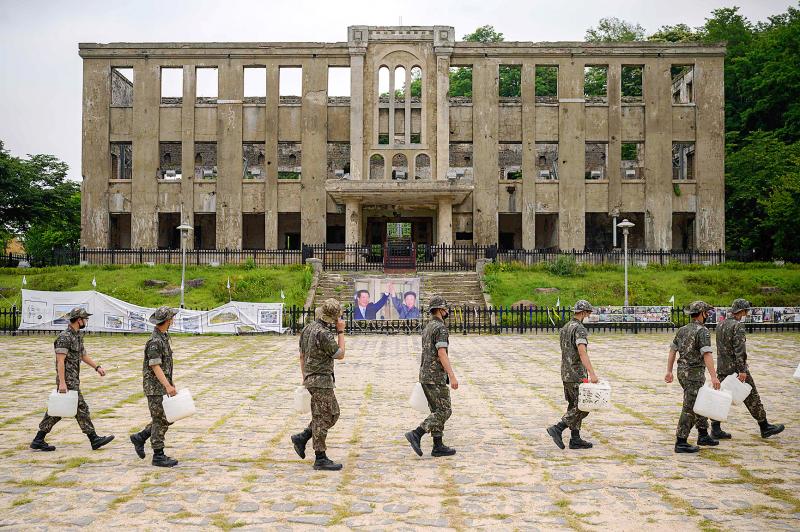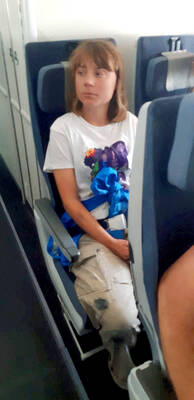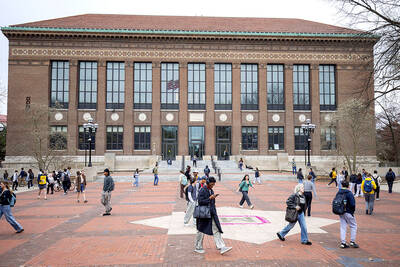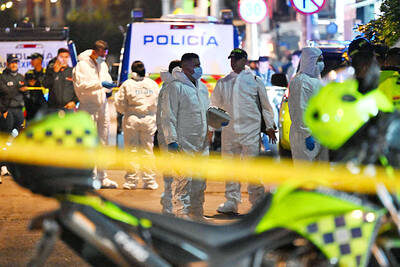From North Korean party headquarters to holiday homes and cemeteries, 70 years after the Korean War began its legacies line the demilitarized zone (DMZ) that marks where the fighting came to a standstill.
A few kilometers from the DMZ’s eastern end, a small stone villa stands on a cliff overlooking the white sands of Hwajinpo Beach in Goseong County, South Korea.
It lay in the North’s territory before the outbreak of war, when it was the summer home of its founder Kim Il-sung, grandfather of North Korean leader Kim Jong-un.

Photo: AFP
Next to the stony steps leading up to the villa — now a museum — is a reprint of a faded 1948 black-and-white photograph showing five children, among them Kim Jong-un’s father and predecessor Kim Jong-il.
Goseong, along with a swathe of what is now South Korea’s Gangwon Province, is north of the 38th parallel line of latitude where the US and Soviet Union divided the peninsula after Japan’s surrender ended World War II and its colonial rule over Korea.
Surrounded by mountain ridges, the peaceful farming village of Haean was the site of some of the most fierce and bloody battles of the war, nicknamed the “Punchbowl” by a US war correspondent who said the area resembled a cocktail glass.
“The South Korean and UN forces had to cross our village in order to advance northwards,” said Lee Byeong-deuk, a tour guide and villager.
Pointing to a faint North Korean mountain top in the distance, Lee, who was born and grew up in Haean, said that his hometown was also used for propaganda: A 1970s government housing project combined every two homes into one to make them look larger — all of them facing north.
Cheorwon County, 60km north of the 38th parallel, also changed hands after the 1950-1953 conflict ended with an armistice.
On a nearly empty road leading to a military checkpoint stands the concrete shell of a three-story building — once the regional headquarters for the North’s ruling Workers’ Party of Korea.
“Where we are standing now used to be North Korea,” tour guide Gim Yong-sun said.
Before the war, she said, the building was a site for questioning and torturing those accused of anti-communist activities.
Hundreds of North Korean troops who never made it home lie in a field outside Paju, the only cemetery in the South for enemy combatants.
Many of the graves hold multiple remains, their simple granite markers saying only the number of they contain, while just a few are named.
At Panmunjom, the truce village in the DMZ with its emblematic blue huts, their successors on both sides come face-to-face.
In the past few years it has seen a series of summits bringing together Kim Jong-un, South Korean President Moon Jae-in and US President Donald Trump.
Yet the armistice has never been replaced by a peace treaty, leaving the peninsula technically still at war, and inter-Korean relations are now in a deep freeze with nuclear negotiations between Pyongyang and Washington at a deadlock.
At the western end of the DMZ, barbed wire fences surround the border island of Gyodong, less than 5km from North Korea.
Barber Ji Gwang-sik was 13 when he fled Yonpek, his North Korean hometown, at the height of the conflict.
It took “less than 30 minutes” for his family to travel across on a wooden boat, Ji said, but for nearly 70 years he has been unable to return.
Now 82, he still waits for the day he can return.
“Only those who had the same experience understand the pain,” he said.

Swedish campaigner Greta Thunberg was deported from Israel yesterday, the Israeli Ministry of Foreign Affairs said, the day after the Israeli navy prevented her and a group of fellow pro-Palestinian activists from sailing to Gaza. Thunberg, 22, was put on a flight to France, the ministry said, adding that she would travel on to Sweden from there. Three other people who had been aboard the charity vessel also agreed to immediate repatriation. Eight other crew members are contesting their deportation order, Israeli rights group Adalah, which advised them, said in a statement. They are being held at a detention center ahead of a

A Chinese scientist was arrested while arriving in the US at Detroit airport, the second case in days involving the alleged smuggling of biological material, authorities said on Monday. The scientist is accused of shipping biological material months ago to staff at a laboratory at the University of Michigan. The FBI, in a court filing, described it as material related to certain worms and requires a government permit. “The guidelines for importing biological materials into the US for research purposes are stringent, but clear, and actions like this undermine the legitimate work of other visiting scholars,” said John Nowak, who leads field

‘THE RED LINE’: Colombian President Gustavo Petro promised a thorough probe into the attack on the senator, who had announced his presidential bid in March Colombian Senator Miguel Uribe Turbay, a possible candidate in the country’s presidential election next year, was shot and wounded at a campaign rally in Bogota on Saturday, authorities said. His conservative Democratic Center party released a statement calling it “an unacceptable act of violence.” The attack took place in a park in the Fontibon neighborhood when armed assailants shot him from behind, said the right-wing Democratic Center, which was the party of former Colombian president Alvaro Uribe. The men are not related. Images circulating on social media showed Uribe Turbay, 39, covered in blood being held by several people. The Santa Fe Foundation

NUCLEAR WARNING: Elites are carelessly fomenting fear and tensions between nuclear powers, perhaps because they have access to shelters, Tulsi Gabbard said After a trip to Hiroshima, US Director of National Intelligence Tulsi Gabbard on Tuesday warned that “warmongers” were pushing the world to the brink of nuclear war. Gabbard did not specify her concerns. Gabbard posted on social media a video of grisly footage from the world’s first nuclear attack and of her staring reflectively at the Hiroshima Peace Memorial. On Aug. 6, 1945, the US obliterated Hiroshima, killing 140,000 people in the explosion and by the end of the year from the uranium bomb’s effects. Three days later, a US plane dropped a plutonium bomb on Nagasaki, leaving abut 74,000 people dead by the